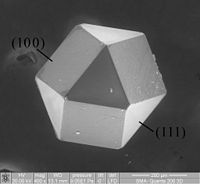
Photo from wikipedia
Abstract This paper develops an inverse method to simultaneously estimate complex Young’s and shear moduli of a rectangular-shaped solid material. This new method exploits a relatively simple experiment and is… Click to show full abstract
Abstract This paper develops an inverse method to simultaneously estimate complex Young’s and shear moduli of a rectangular-shaped solid material. This new method exploits a relatively simple experiment and is designed for a frequency range of approximately 1 kHz–10 kHz. A fully elastic spatial domain model of a plate is derived and corresponding experimental measurements are collected. An error function is defined using the residual between the model displacements and the measured displacements, which allows a metric for a search over a space where the complex model values of Young’s and shear moduli are allowed to vary. When this error function is minimized, the parameters used to create the model are considered the best estimate possible. An experiment is included to illustrate the estimation process, and it is shown that the real parts of both moduli compare favorably to previously available measurements. Finally, the model is compared to the experimental measurements to illustrate its accuracy when it is formulated using the material property estimates obtained using this method.
Journal Title: Journal of Sound and Vibration
Year Published: 2019
Link to full text (if available)
Share on Social Media: Sign Up to like & get
recommendations!